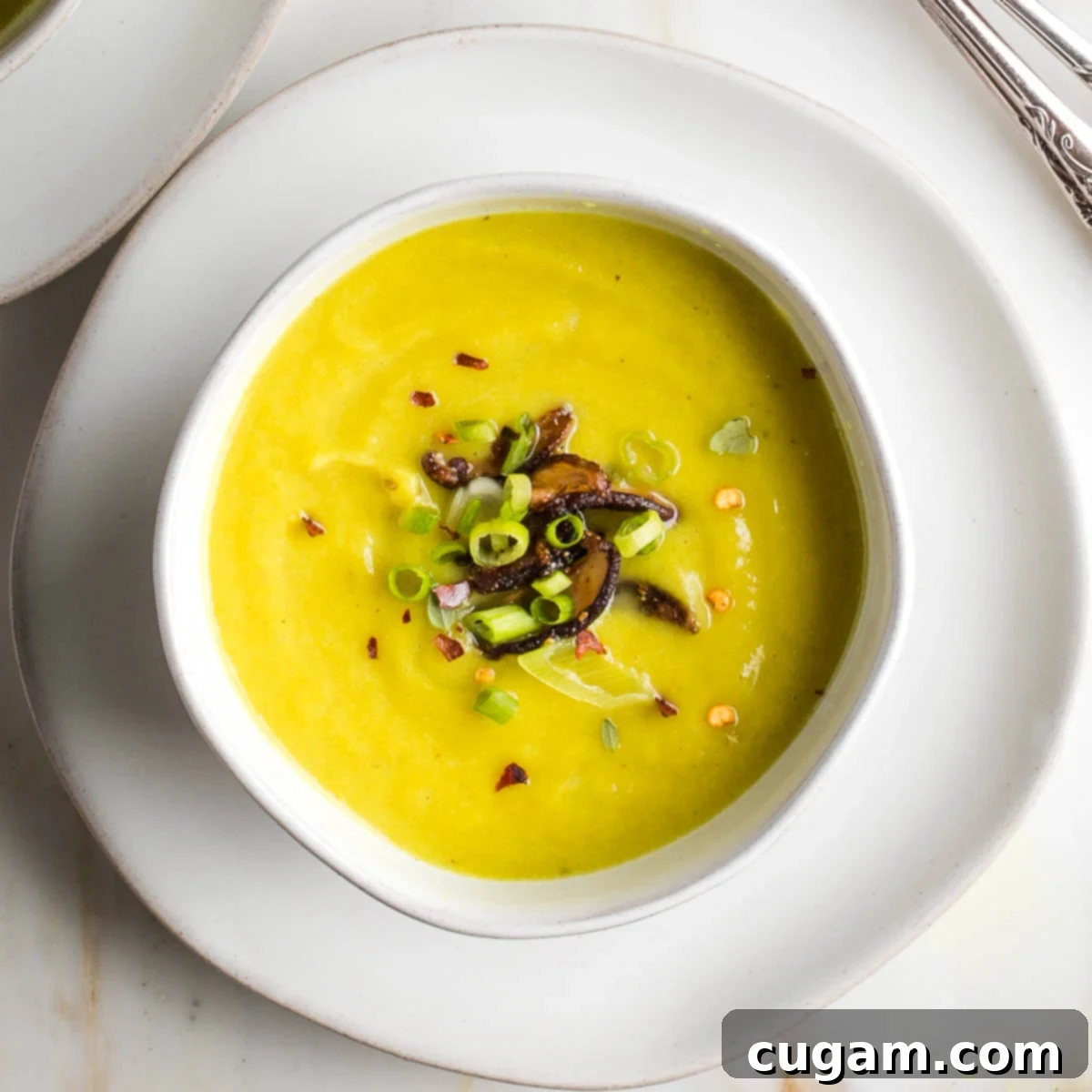Creamy Vegan Leek and Cauliflower Soup (No Potatoes!): A Healthy, Easy & Delicious Recipe
Craving a bowl of luxuriously creamy, deeply comforting soup but want to skip the potatoes? This Leek Soup Without Potatoes is your new go-to recipe! It’s incredibly easy to make, remarkably flavorful, and offers a lighter, healthier take on the classic. Say goodbye to heavy cream and starchy potatoes, and hello to a vibrant, satisfying vegan leek and cauliflower soup that will quickly become a family favorite.
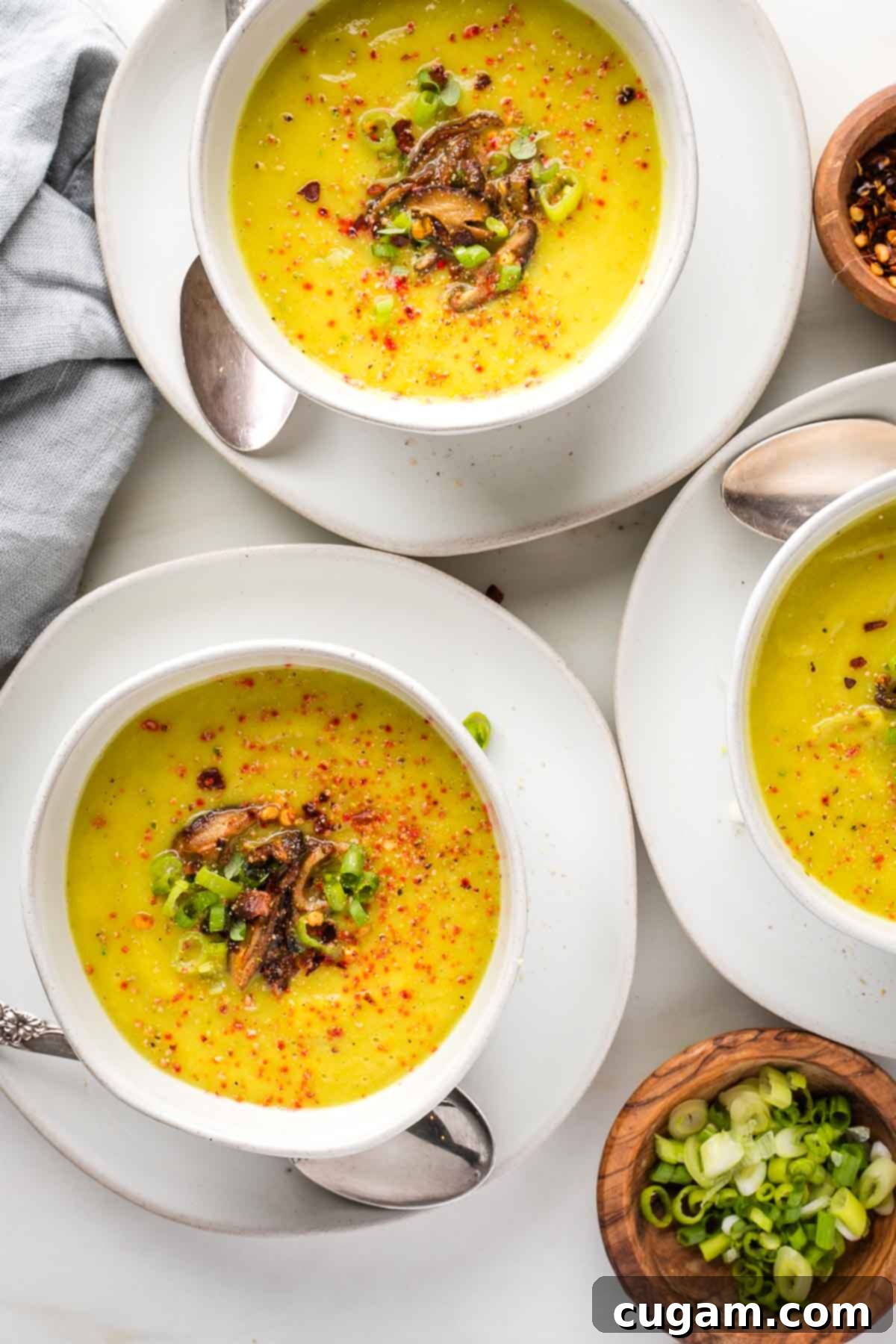
This post has been updated from the original posted March 5, 2018, to provide even more details, enhanced SEO, and improved recipe clarity.
For years, I’ve cherished the classic potato leek soup for its comforting warmth and delightful creaminess. The health benefits of leeks have always been a major draw, adding both flavor and nutritional value to every spoonful. While traditional recipes often call for chicken broth, swapping it for vegetable broth effortlessly transforms it into a delicious vegan potato leek soup.
However, what if you could take that beloved recipe one step further, elevating its nutritional profile without sacrificing any of the creamy texture or rich taste? This is where cauliflower truly shines! By replacing potatoes with cauliflower, we create an incredibly creamy soup that’s not only a healthier choice but also packed with flavor that the whole family will adore. Cauliflower is a fantastic low-carb substitute for potatoes; when pureed, it mimics the same velvety texture, yet it offers fewer calories and a wealth of essential vitamins, minerals, and significant health benefits. It’s truly a game-changer for a lighter, more wholesome soup.
Looking to start the Jewish New Year off with healthy and delicious recipes? No Jewish holiday is complete without an abundance of yummy food. Check out my roundup of Healthy Rosh Hashanah Recipes to add something new to your menus this year.
The Wholesome Nutritional Benefits of This Leek Soup
Leeks, like their allium cousins garlic and onions, are nutritional powerhouses. This creamy leek and cauliflower soup is not just a treat for your taste buds but also a boost for your health. Here’s why this recipe stands out:
- Enhanced Nutrient Absorption: To maximize the benefits of allium vegetables like leeks, it’s a good practice to cut them at least 10 minutes before you’re ready to cook. This process helps break down their cell walls and activates beneficial enzymes.
- Is this leek soup healthy? Absolutely! Leeks offer a wide array of health benefits, including improved digestion, reduction of inflammation, and support for healthier skin, teeth, and eyes. Unlike traditional leek soups that often rely on heavy cream, heavily processed vegetable oils, and sour cream garnishes, this recipe takes a much healthier approach.
- A Healthier Twist: Our version prioritizes your well-being. We use nutritious vegetable stock, completely omit dairy, and swap out starchy potatoes for fiber-rich cauliflower. This cauliflower and leek soup remains wonderfully rich and creamy, incredibly satisfying, and presents a delicious, guilt-free alternative to the conventional recipe.
- Rich in Vitamins and Minerals: Both leeks and cauliflower are packed with essential nutrients. Leeks provide Vitamin K, Vitamin A, and manganese, while cauliflower is an excellent source of Vitamin C, Vitamin K, and folate. Together, they create a nutrient-dense meal.
- Fiber-Packed: The high fiber content from leeks, cauliflower, and parsnips aids in digestion, promotes satiety, and helps maintain healthy blood sugar levels, making this soup incredibly filling.
Main Ingredients and Smart Substitutions
Crafting the perfect leek soup without potatoes starts with selecting the right ingredients. Each component in this recipe plays a vital role in building its depth of flavor and creamy texture. Here’s a closer look at what you’ll need and some clever substitutions:
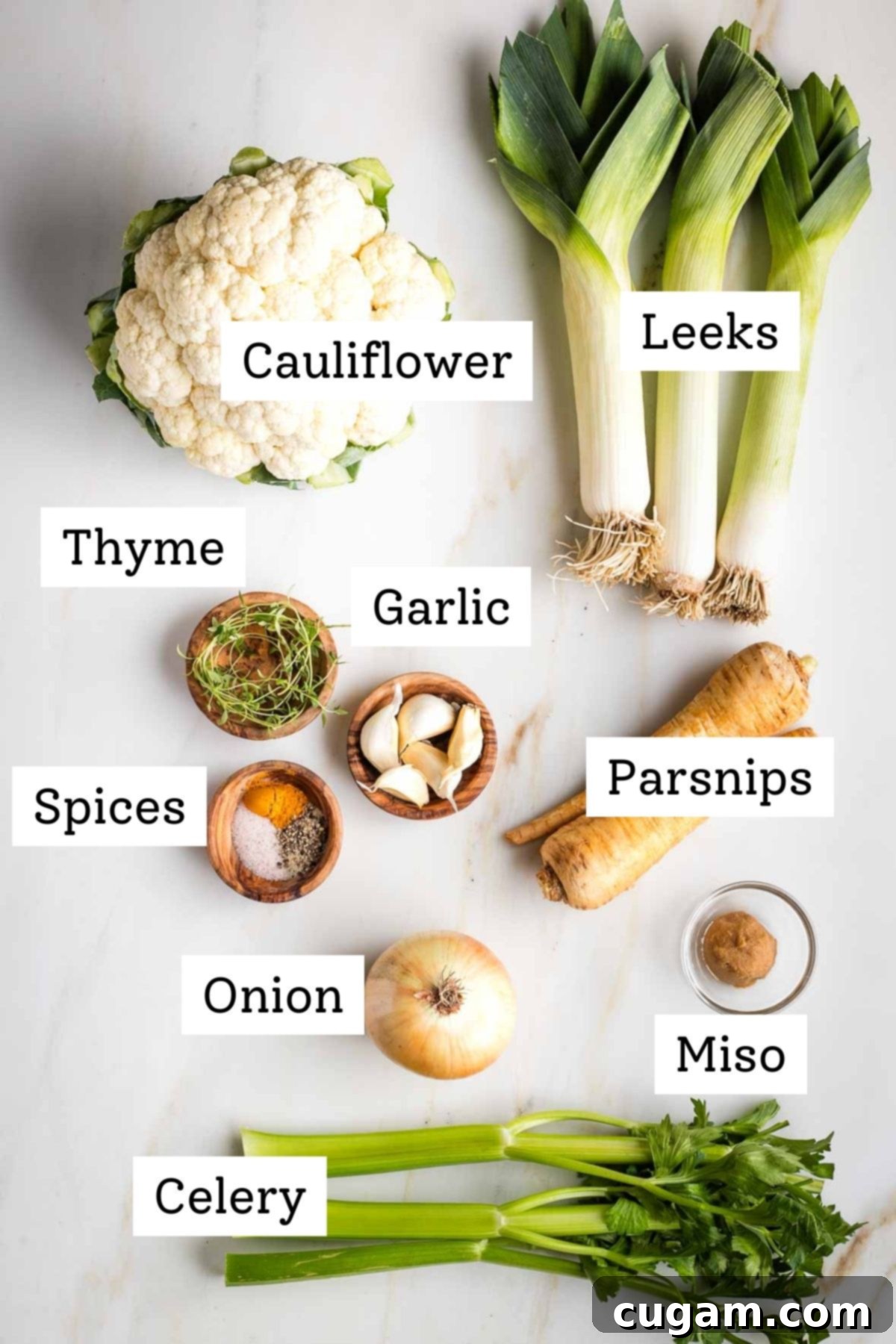
- Leeks: These elegant vegetables offer a subtle oniony flavor that’s both sweet and slightly earthy, forming the heart of our soup. They provide a milder, more refined taste compared to regular onions. If leeks are hard to find, a combination of scallions (green onions) and a regular onion can work as a substitute, though the flavor profile will differ slightly. The recipe also calls for an additional onion; you can use extra leeks if you prefer their unique flavor.
- Cauliflower: The star of our potato-free mission! Cauliflower is significantly lower in carbs and richer in nutrients than potatoes. When cooked until tender and pureed, it brilliantly replicates the creamy, luxurious texture of potato leek soup, making it an ideal low-carb substitute. For convenience, frozen cauliflower florets can be used, eliminating prep time. Even cauliflower rice can be used to speed up cooking.
- Parsnips: Another fantastic potato swap! Parsnips add a touch of sweetness and a subtle, earthy, slightly spicy flavor that truly enhances the complexity of this soup. Beyond their delicious taste, parsnips are a nutritional powerhouse, rich in iron, potassium, magnesium, copper, zinc, phosphorus, fiber, and potent anti-inflammatory properties. Their unique flavor deepens the soup’s profile.
- Vegetable Broth: The foundation of our vegan soup. For the freshest and most controlled flavor, I highly recommend making your own homemade veggie broth. I always keep a batch stocked in my freezer for easy access. If you opt for store-bought broth, be sure to read labels carefully to choose a brand that avoids processed vegetable oils, excessive sodium, and unwanted additives.
- Miso: This fermented soybean paste is a secret weapon for boosting plant-based flavor, adding a rich umami depth without relying on animal products. I frequently use it as a flavor enhancer, for example, in my vegan split pea soup. It contributes a salty, savory note that rounds out the soup beautifully.
- Garlic, Onion, Spices, Fresh Thyme: These aromatic ingredients are crucial for building layers of wholesome flavor. They allow us to create a deeply satisfying soup without needing to rely on excessive oil, sugar, or salt. Fresh thyme, in particular, adds a bright, herbaceous note that elevates the entire dish.
Why You’ll Fall in Love with This Creamy Leek Soup Recipe
This potato-free leek soup isn’t just another recipe; it’s a culinary revelation that brings comfort and health to your kitchen. Here’s why this particular recipe is destined to become a beloved staple:
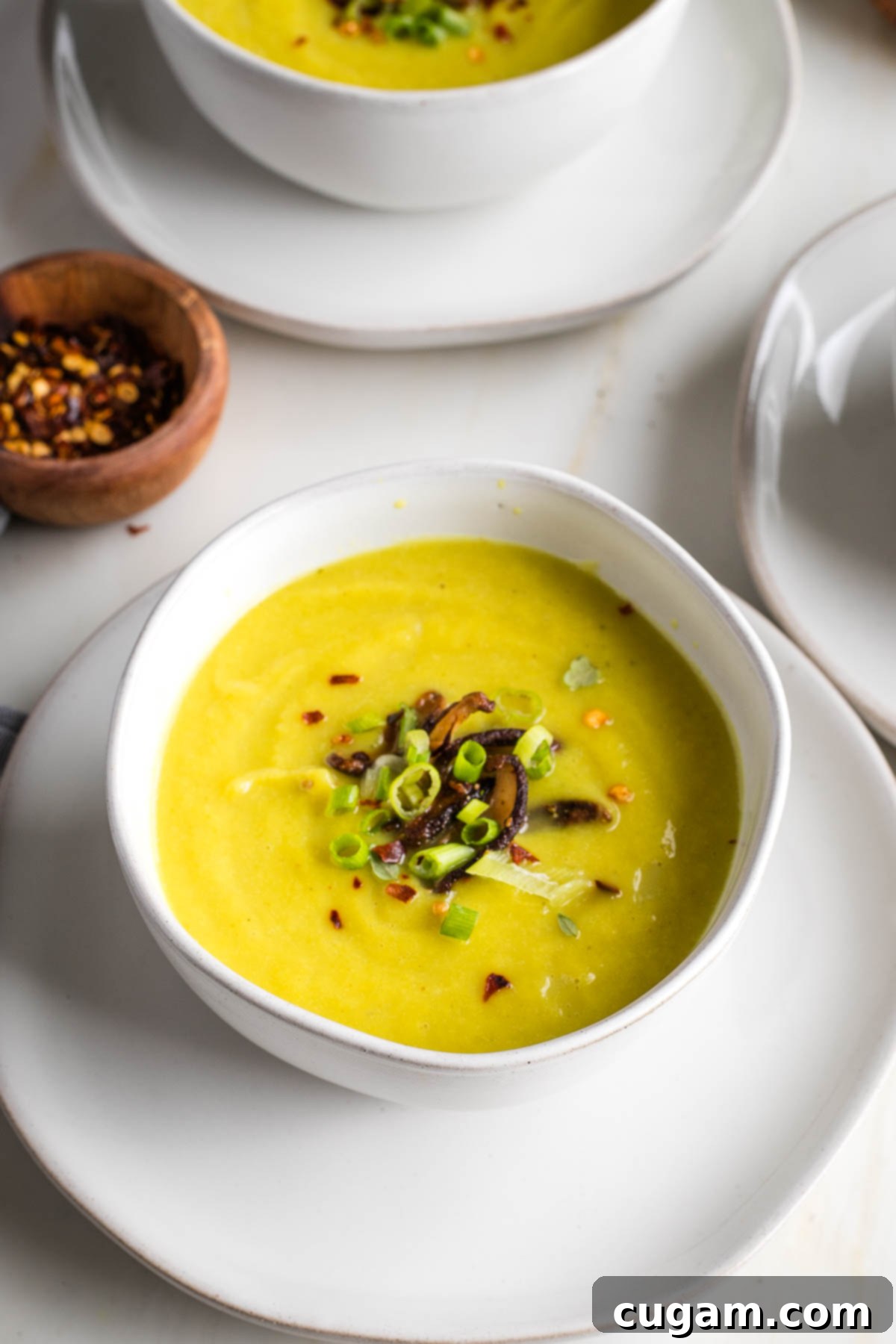
- All the Creaminess, None of the Guilt: Enjoy the rich, velvety texture and incredible flavor of a traditional creamy potato leek soup, but with significantly fewer carbohydrates and calories. It’s the ultimate healthy comfort food.
- Effortlessly Delicious: This is a straightforward pureed vegetable soup recipe that is both simple to prepare and wonderfully satisfying. Minimal fuss, maximum flavor!
- Perfect for Meal Prep: This soup freezes beautifully, making it an ideal candidate for meal prepping. Whip up a large batch, store it, and enjoy a delicious, healthy meal whenever you need it. It reheats like a dream, maintaining its delightful texture and taste.
- The Ultimate Comfort Food: There’s nothing quite like scooping up a hearty, warm bowl of this soup with a piece of crusty bread. It’s pure comfort in a bowl, perfect for chilly evenings or any time you need a warming embrace.
- Diet-Friendly and Inclusive: This recipe is naturally vegan and gluten-free, making it suitable for a wide range of dietary needs and preferences. Plus, it’s crafted with no added oil, focusing on the natural goodness of the ingredients.
- Versatile Serving Options: While delicious hot, this soup can also be served chilled, making it a refreshing option for warmer weather – a healthier alternative to classic Vichyssoise!
Mastering the Art of Washing Leeks
Leeks are notorious for holding onto dirt and grit between their layers. Proper cleaning is essential to ensure your soup is smooth and delightful, not gritty. Here’s a simple, effective method:
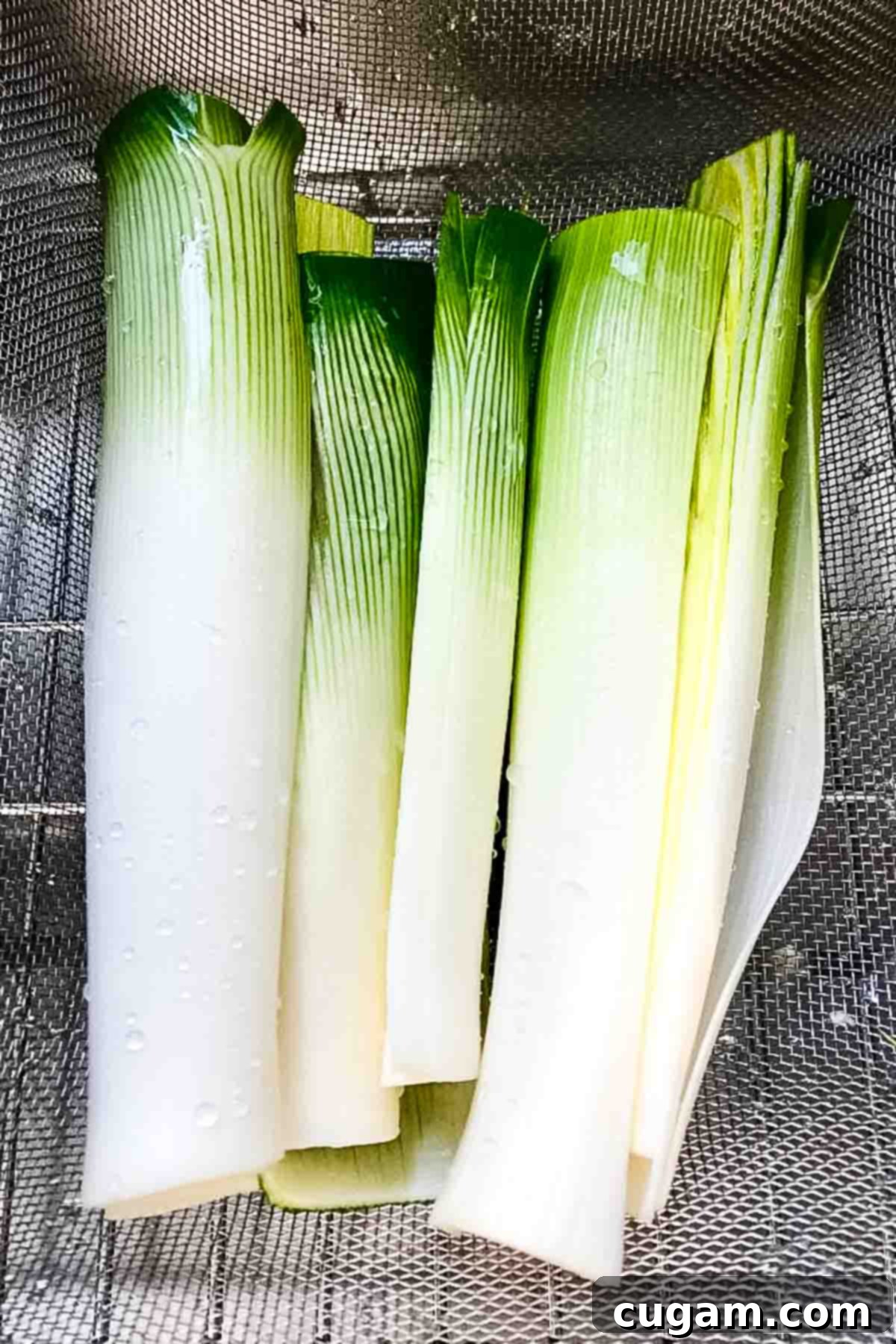
- Trim the Ends: Begin by trimming off the tough, root end and the dark, woody green part of the leek. You can keep some of the lighter green parts that are still pliable and tender, as they add both color and flavor.
- Cut Lengthwise: Carefully cut each leek in half lengthwise, from the white part almost up to the green end. This exposes the inner layers where dirt often hides.
- Rinse Thoroughly: Hold the cut leeks under cold running water, fanning out the layers as you rinse. Pull the layers apart gently if necessary to ensure all trapped dirt is dislodged and washed away. Repeat until no more dirt is visible.
What Part of Leeks Do You Use for Soup?
When preparing leeks for soup, you generally want to focus on the tender, flavorful parts. The best part of the leek for adding robust flavor and achieving a smooth texture in soup is the white and light green section. These parts are more tender and contribute a sweet, delicate oniony taste that is characteristic of leek soup.
While the darker green parts of the leek are edible, they tend to be tougher and more fibrous. If you wish to use them to minimize waste, a quick sautéing or simmering for a longer period will help soften them, making them more palatable for your leek soup. However, for the creamiest and most refined soup, prioritize the white and pale green sections.
Understanding Vichyssoise: A Healthy Alternative
For those unfamiliar, Vichyssoise is a French word that literally means “cream of potato and leek soup.” Traditionally, this elegant soup is served chilled, offering a refreshing culinary experience. Legend has it that Louis Diat, a French chef from Vichy, created the cold version of leek and potato soup by stirring in cold milk, serving it at the prestigious Ritz-Carlton in New York.
Our vegan leek soup without potatoes offers a fantastic, healthier alternative to this French classic. It boasts all the creamy texture and delicate flavor profiles without the heavy cream and starchy potatoes. The best part? This versatile soup tastes absolutely phenomenal served both hot and cold! This makes it an excellent choice for any season – a comforting, warm dish in the winter, and a wonderfully refreshing treat to serve during hot summer months, just like its traditional counterpart.
How to Make Creamy Leek Soup Without Potatoes
Creating this delightful, potato-free leek soup is a straightforward process, but preparing your ingredients beforehand will make it even smoother. You’ll need a good chef’s knife, a sturdy wooden cutting board, a Dutch ovenor a large pot, and an immersion blender (or a high-speed blender) to achieve that silky-smooth consistency.
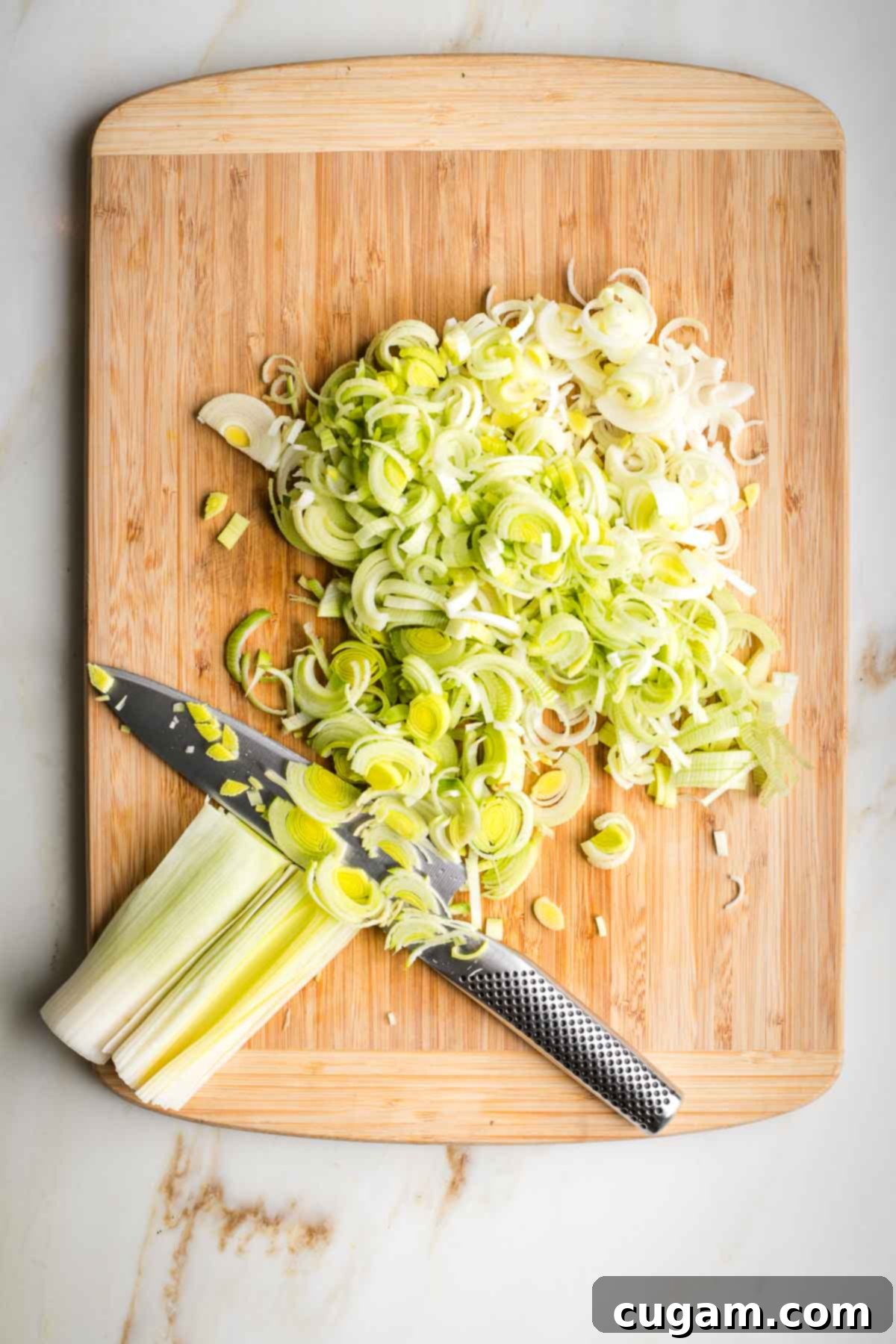
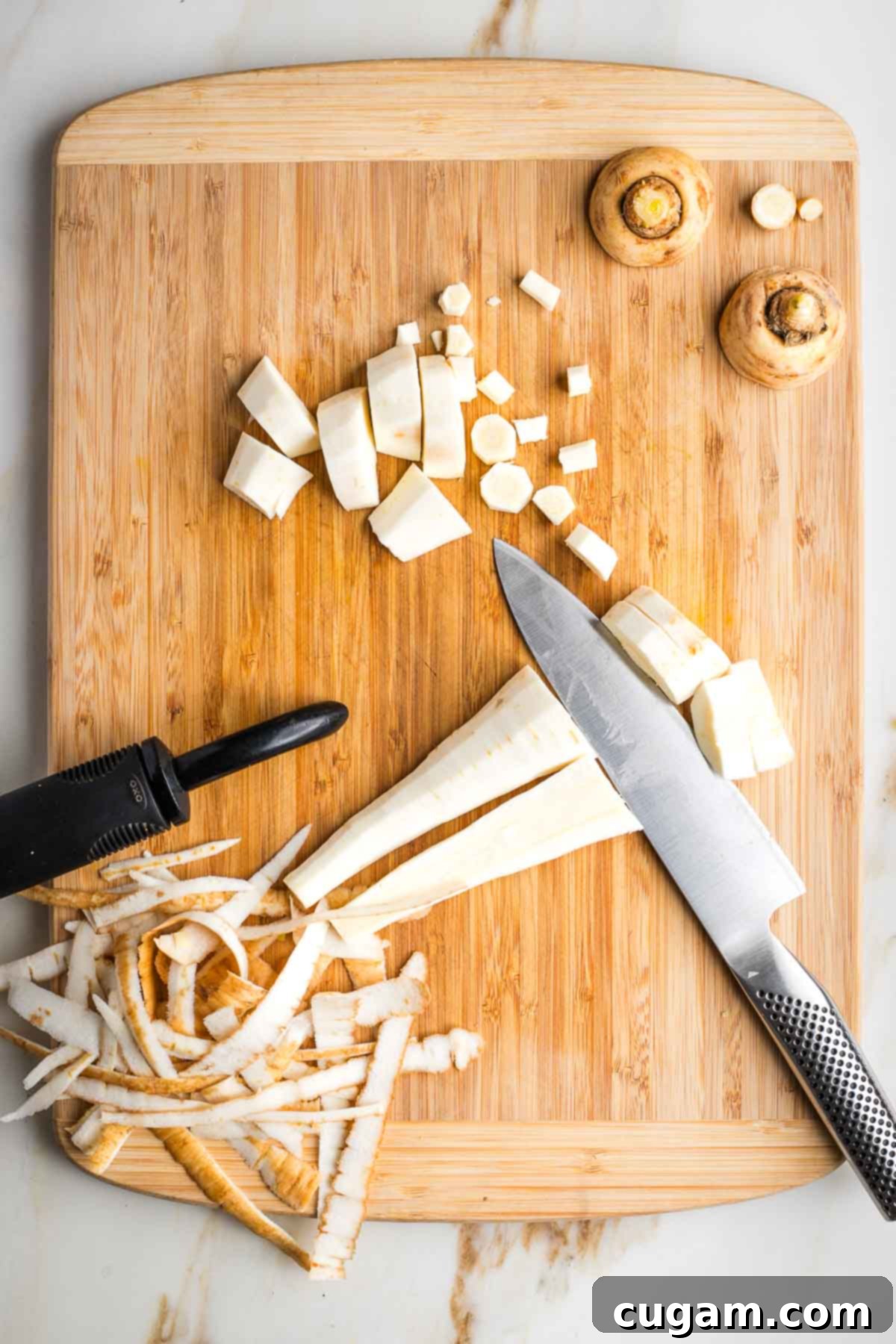
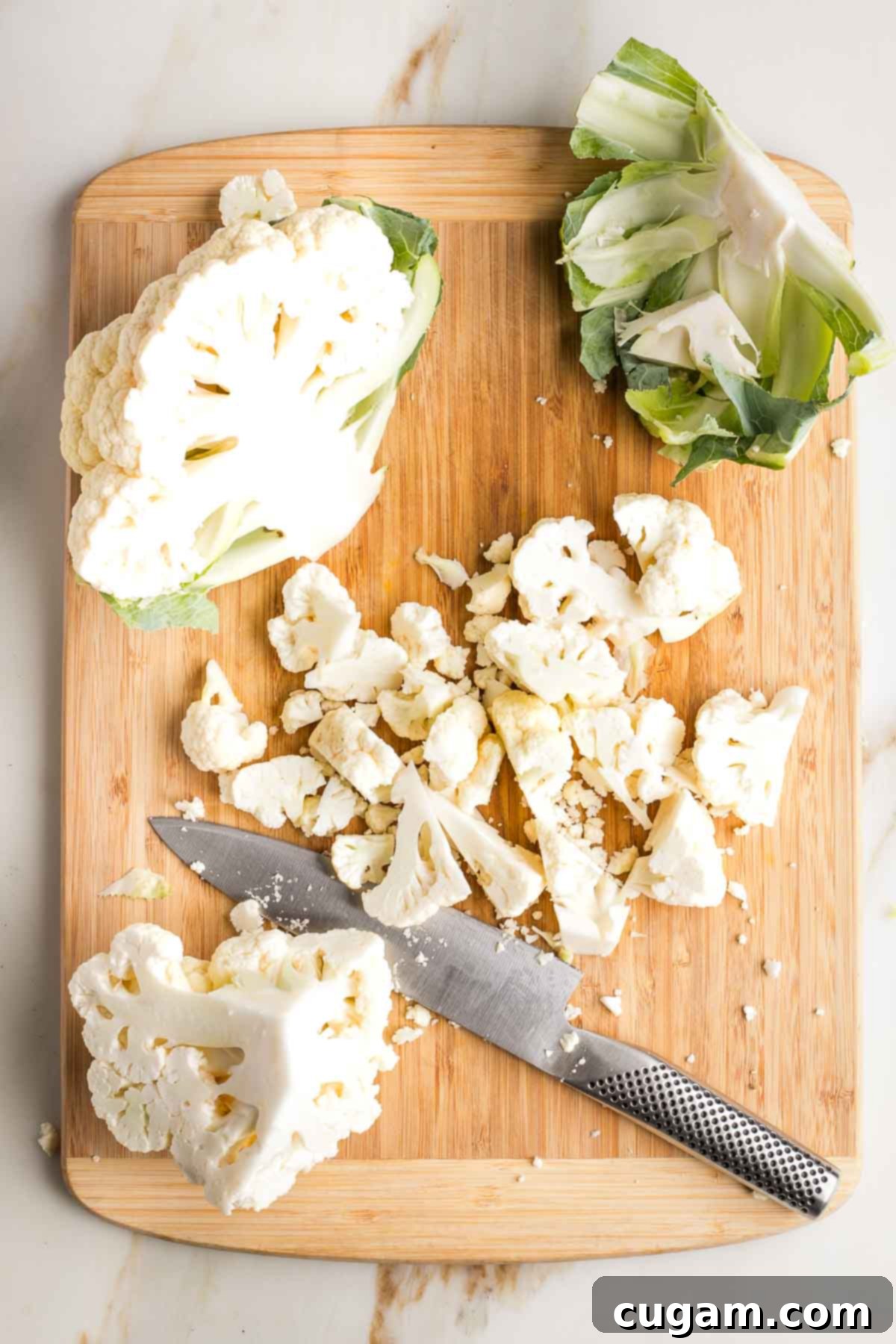
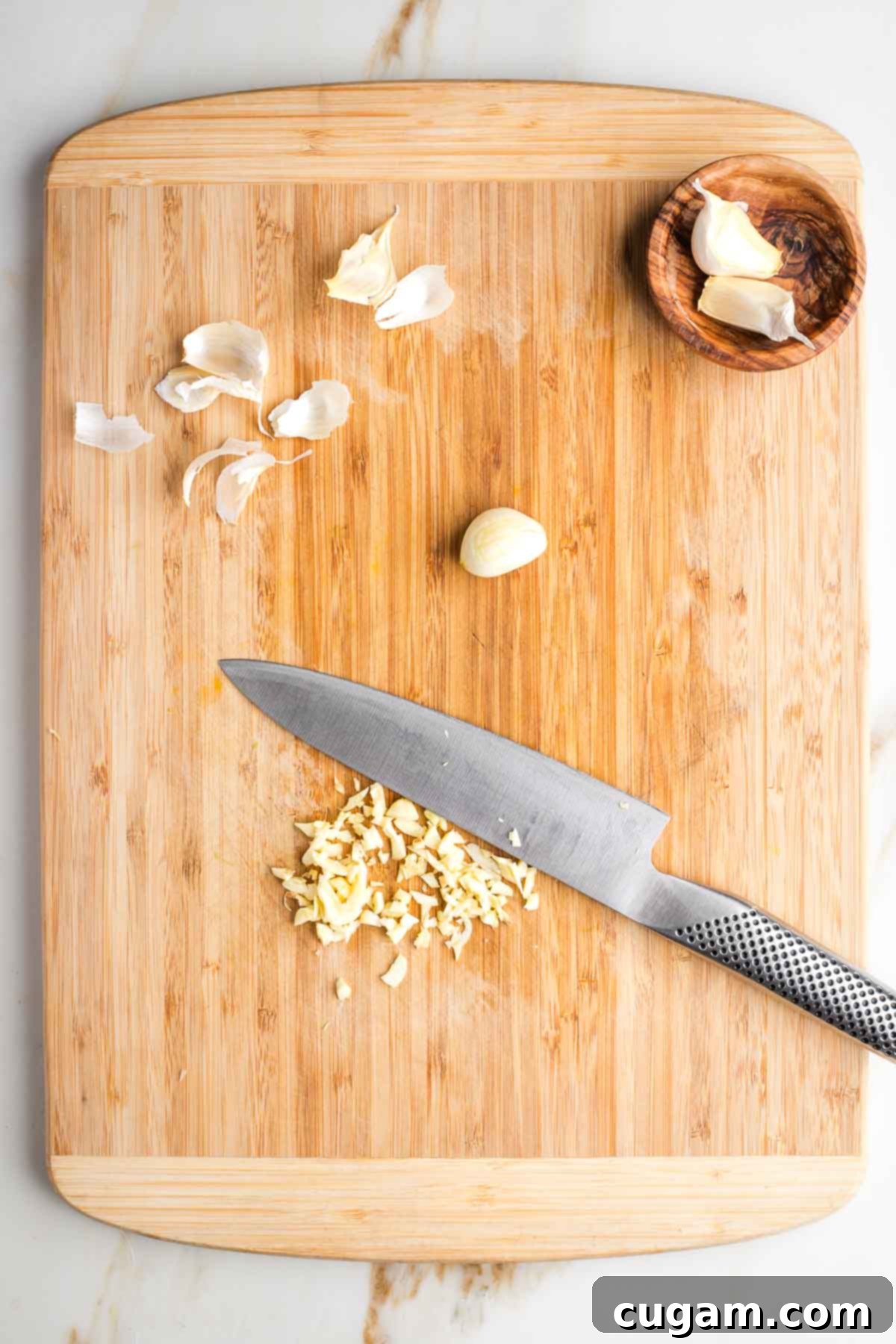
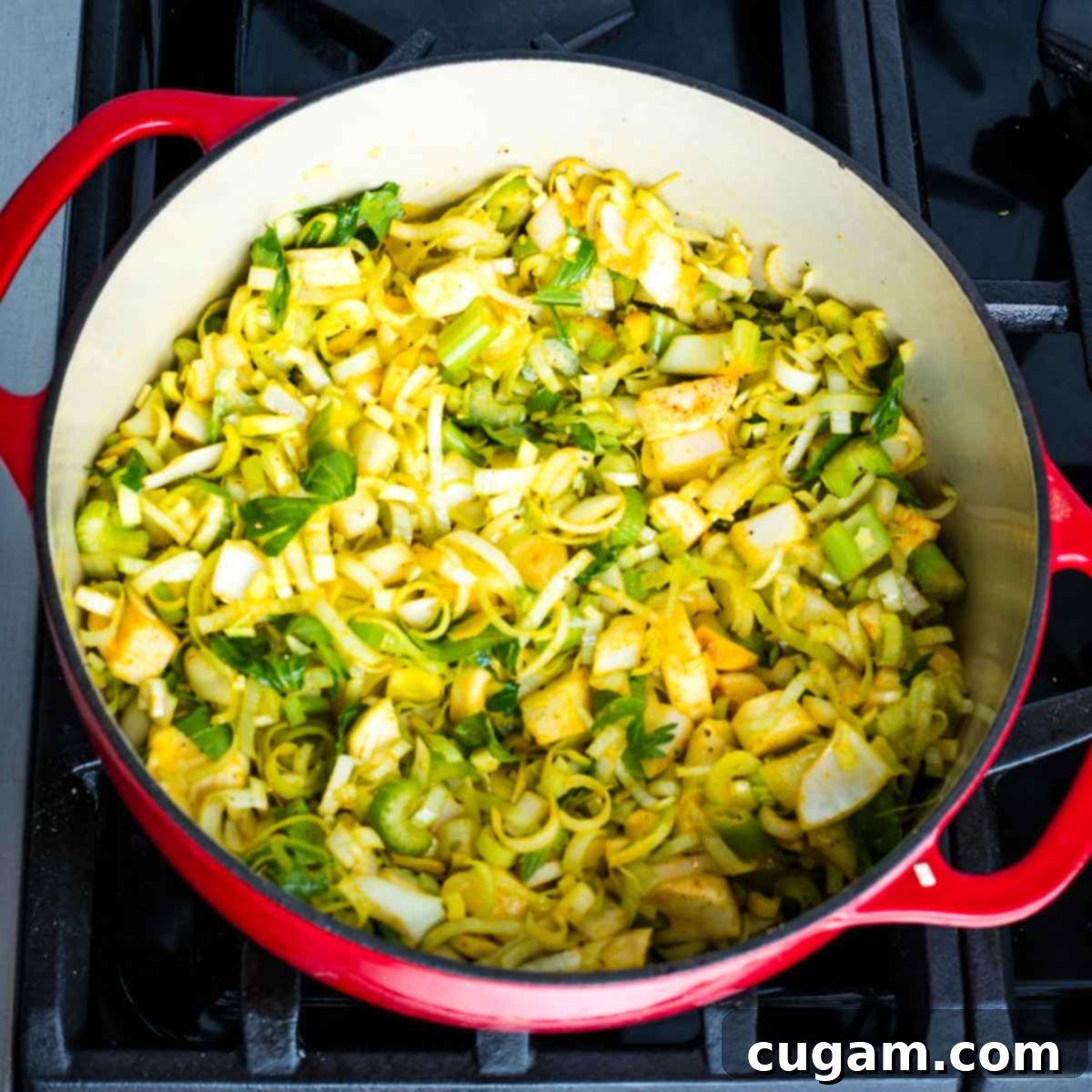
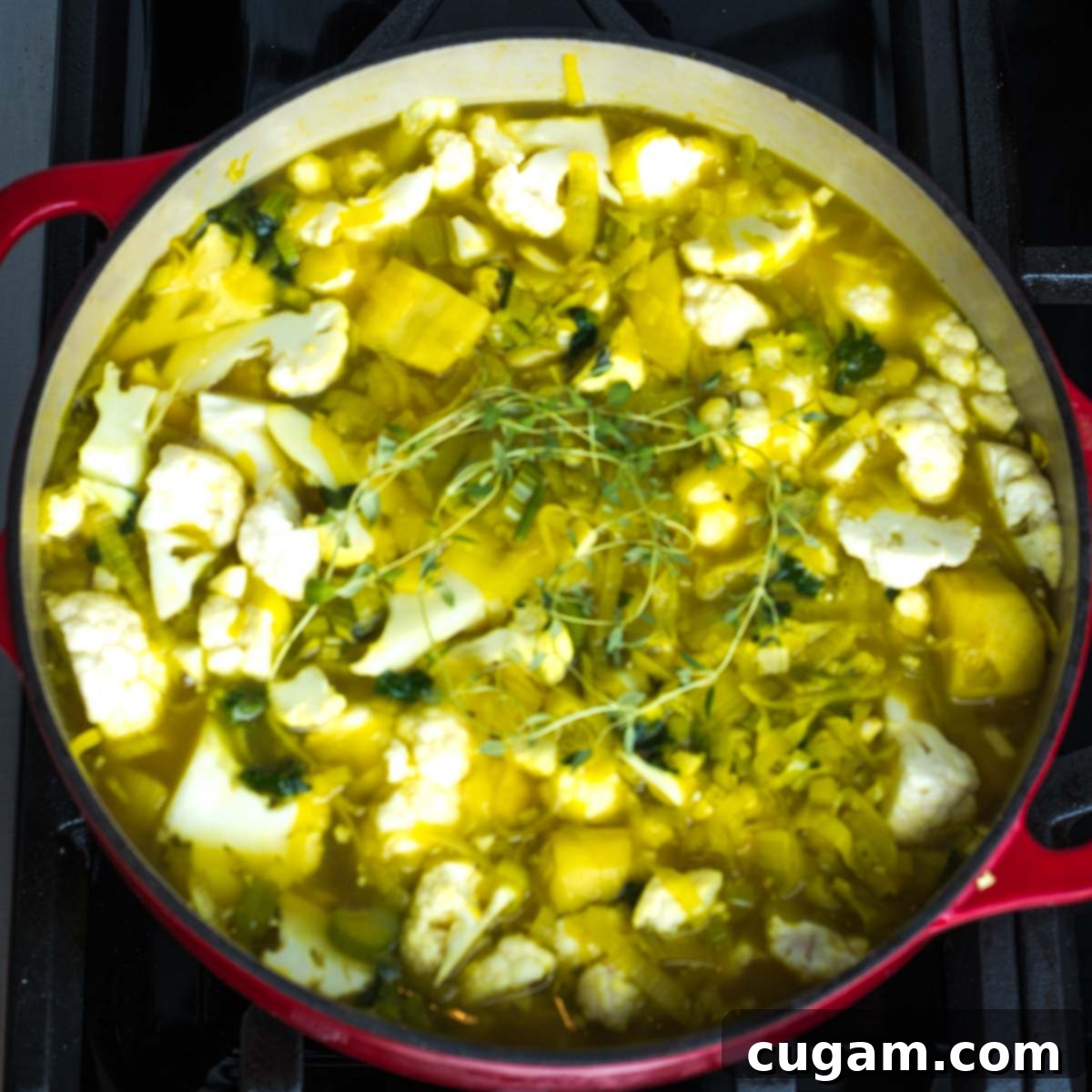
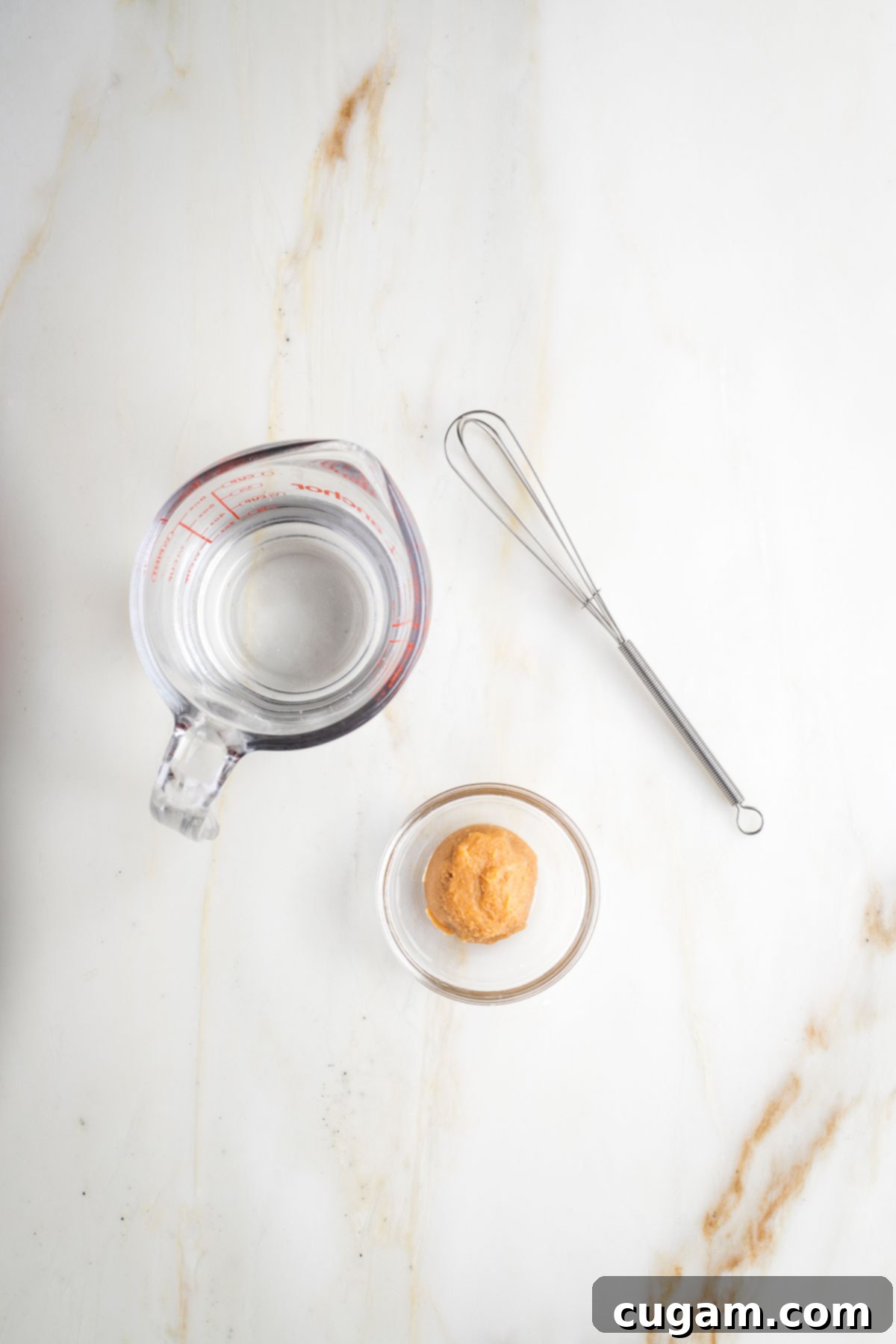
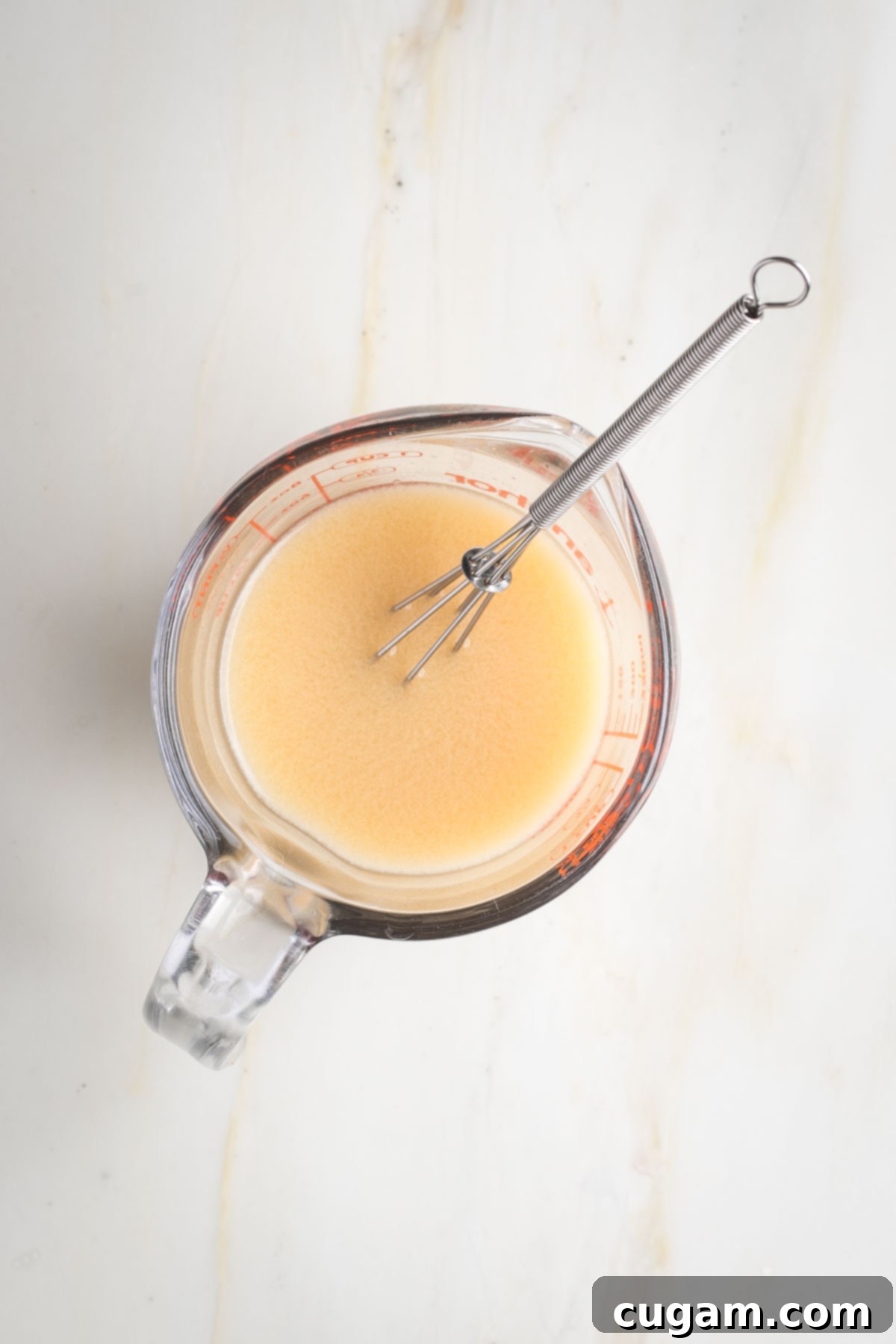
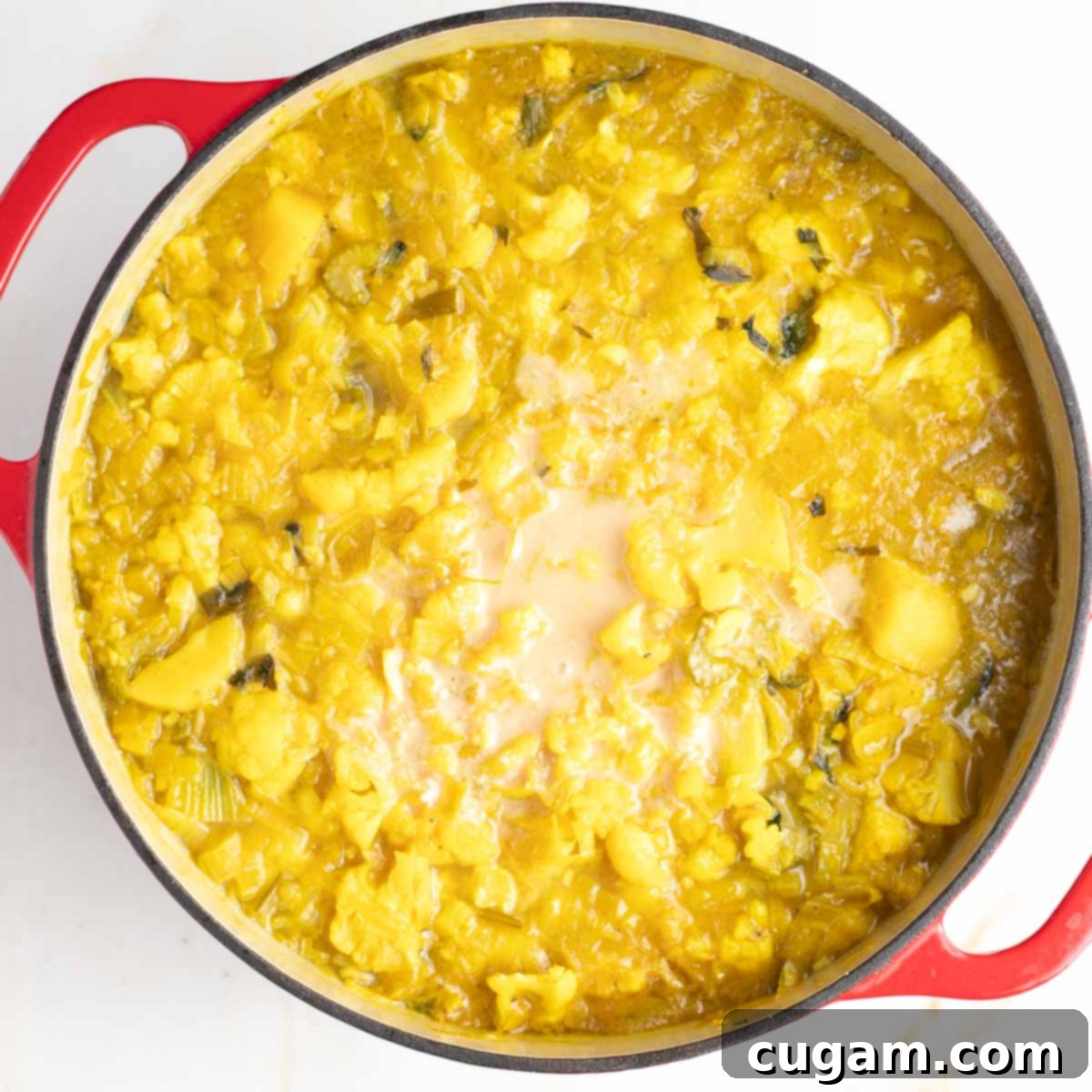
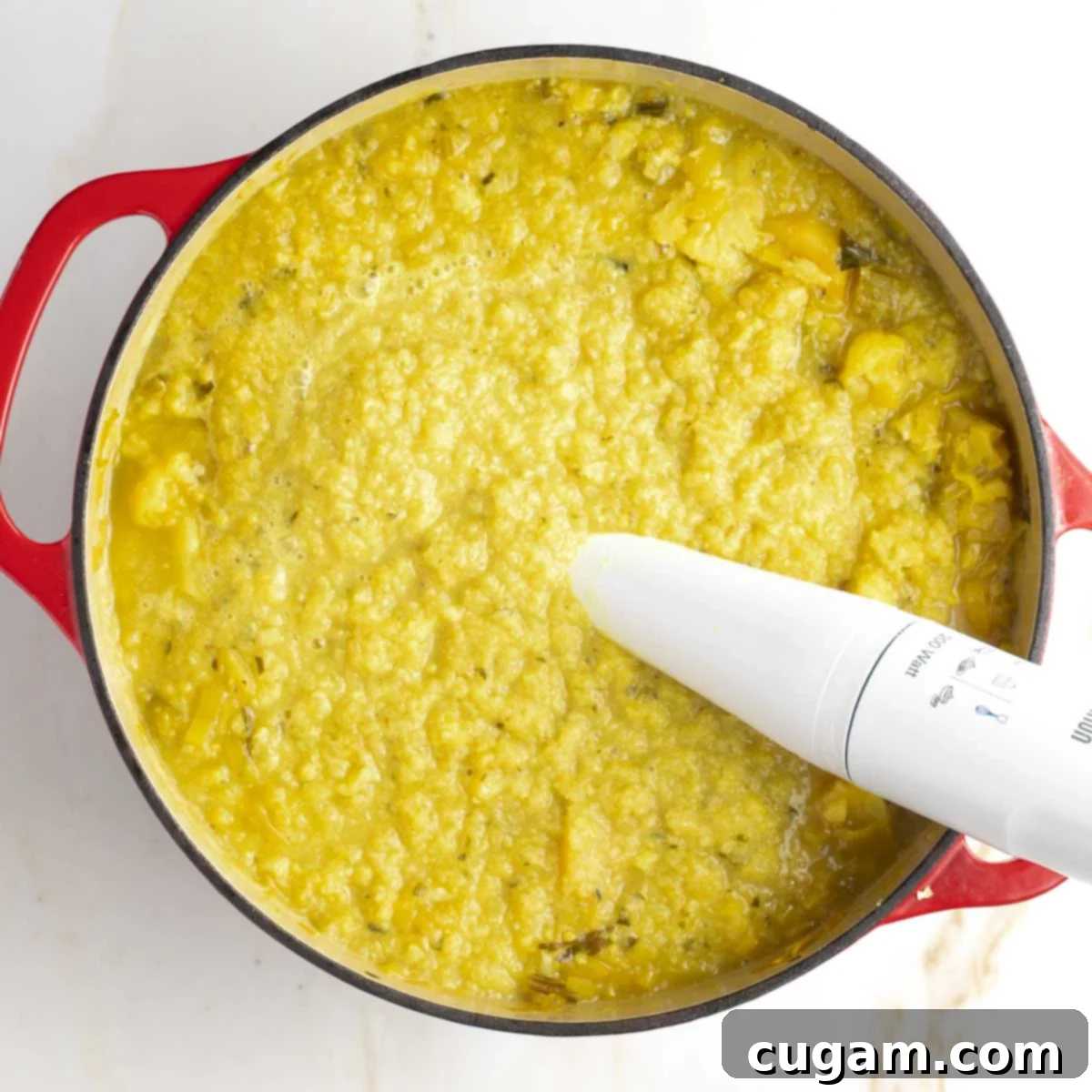
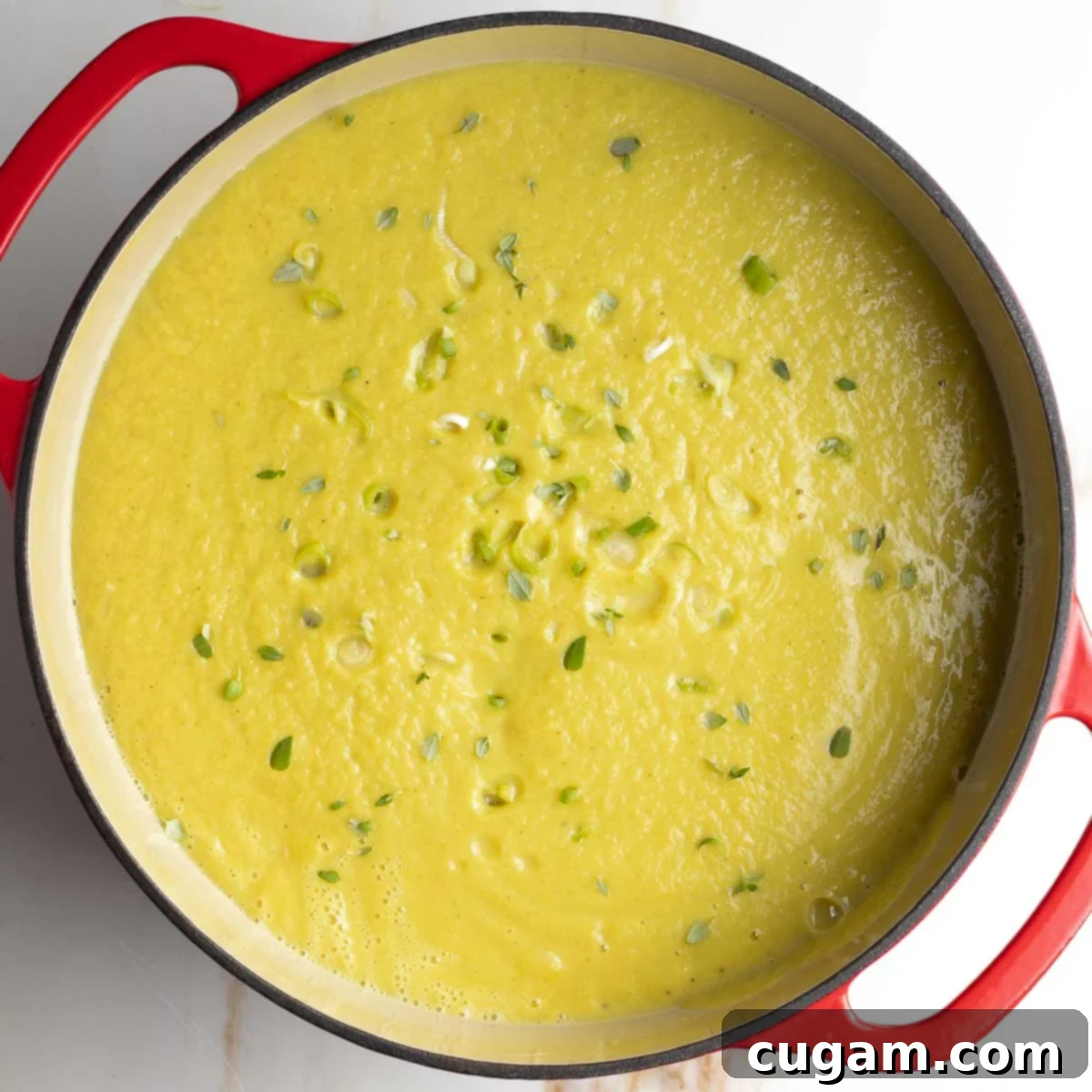
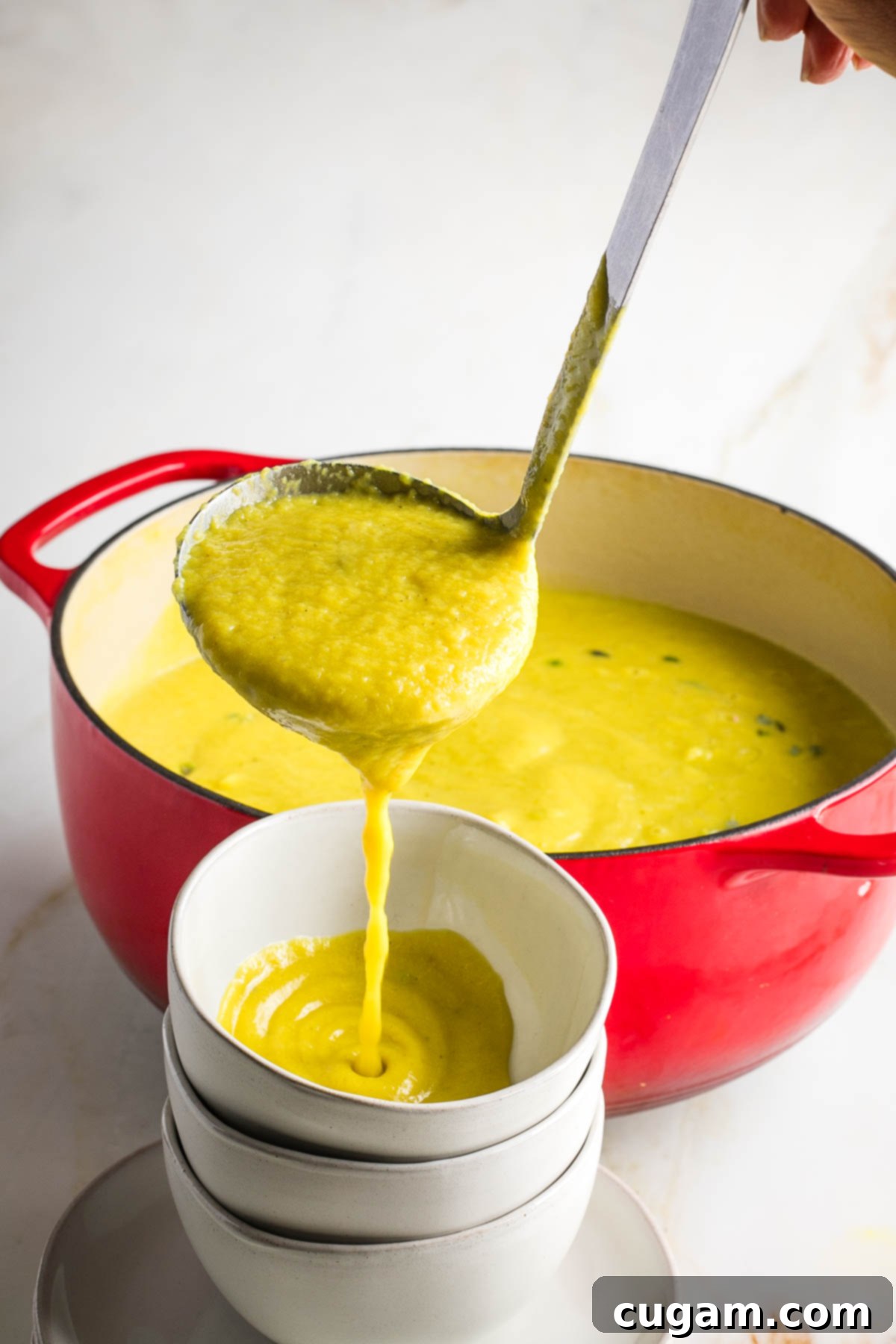
Debra’s Pro Tips for the Perfect Leek & Cauliflower Soup
Elevate your leek and cauliflower soup from delicious to extraordinary with these expert tips:
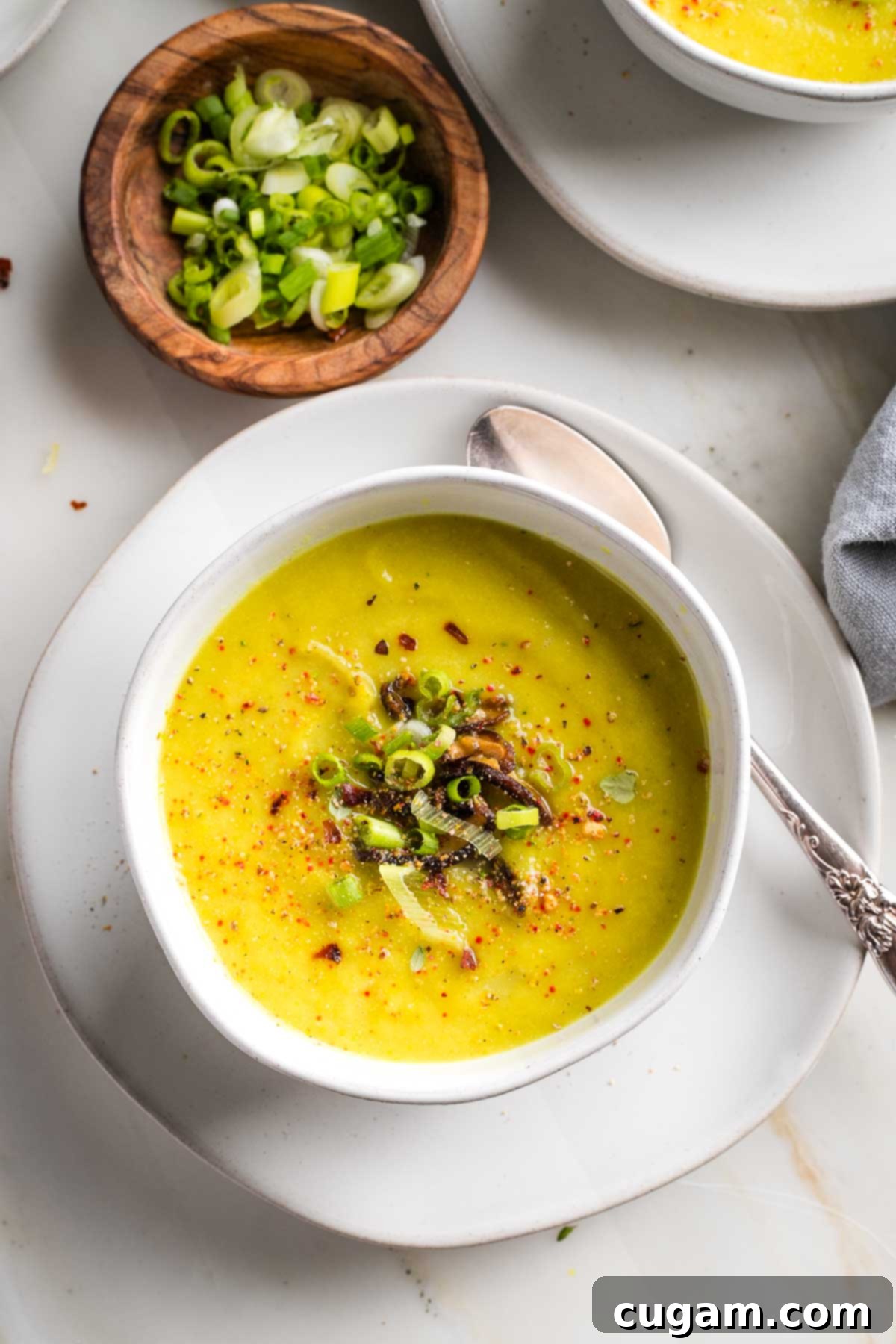
- Achieving Ultimate Smoothness: If you desire an ultra-smooth, restaurant-quality texture, transfer the cooked soup in batches to a high-speed blender. Be sure to fill the blender only halfway and secure the lid tightly to prevent splashes from hot liquids. Otherwise, an immersion blender is a convenient tool that will still yield a beautifully creamy consistency directly in the pot.
- Time-Saving Cauliflower Hacks: To cut down on prep time, opt for pre-cut frozen cauliflower florets. If you’re really in a rush, using frozen cauliflower rice can significantly reduce cooking time as it softens much faster.
- Harnessing Fresh Thyme: Fresh thyme sprigs impart a superior, brighter flavor to the soup. Remember to remove the woody stems before blending to ensure a smooth texture. If fresh thyme isn’t available, 1 teaspoon of dried thyme can be used, but add it during the sautéing stage.
- Umami Boost with Shiitake Mushrooms: For an extra layer of savory umami satisfaction, sauté thinly sliced shiitake mushrooms with a pinch of salt and pepper until they are tender and slightly chewy. Sprinkle these onto each bowl of soup just before serving for a gourmet touch.
- Year-Round Enjoyment: This versatile soup can be enjoyed steaming hot during the colder months for a comforting meal. Alternatively, serve it chilled for a refreshing and light summer treat, offering a healthy twist on traditional cold soups.
- Adjust Seasoning to Taste: Always taste your soup before serving and adjust salt and pepper as needed. The final seasoning can make all the difference!
How to Store and Freeze This Delicious Soup
This leek and cauliflower soup is perfect for meal prepping, as it stores and freezes beautifully, allowing you to enjoy its comforting flavors whenever you like.
- Refrigeration: Store leftover soup in an airtight container in the fridge for up to 5-7 days. Its flavors often deepen and improve overnight!
- Freezing for Longer Storage: For longer preservation, this soup can be frozen for up to 3 months.
- Optimal Freezing Containers: Utilize wide-mouth mason jars or freezer-safe zip-top bags. If using bags, lay them flat in the freezer to save space.
- Allow for Expansion: Remember that liquids expand when frozen. If using containers, leave 1-2 inches of headspace from the top to prevent cracking.
- Labeling is Key: Always label your containers with the name of the soup and the date it was made. This helps you keep track and ensure freshness.
- Reheating Instructions: To reheat, simply transfer the frozen soup to a saucepan and warm it gently over medium-low heat on the stove, stirring occasionally, until it’s heated through. If it’s too thick, add a splash of vegetable broth or water to reach your desired consistency.
Explore More Delicious Pureed Vegetable Soups
If you’ve enjoyed the creamy texture and wholesome goodness of this Leek and Cauliflower Soup, you’re in for a treat! Our collection of pureed vegetable soups offers a variety of flavors and nutrients, perfect for healthy and comforting meals. Explore these other fantastic recipes:
- Creamy Vegan Asparagus Soup without Cream
- Easy Vegan Butternut Squash Soup
- Zucchini Soup Recipe
- Vegan Carrot Ginger Soup
Your feedback means the world to us! Did you know commenting and rating recipes is one of the best ways to support your favorite food bloggers? If you made this incredibly delicious Leek Soup Without Potatoes, please consider leaving a five-star rating below and sharing your thoughts in a comment. We’d also love to see your culinary creations! Please share your photos on Instagram by tagging me @dkhealthcoach and using the hashtag #debraklein. Your support helps us continue to share healthy and inspiring recipes!
📖 Recipe
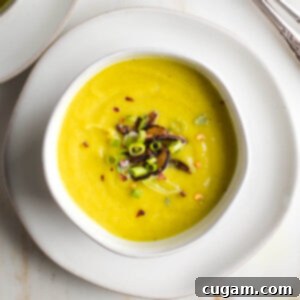
Leek Soup without Potatoes
Rate this Recipe
Pin Recipe
Equipment
-
Dutch oven
-
Immersion blender
Ingredients
- 3 leeks washed and thinly sliced
- 3 ribs celery thinly sliced
- 1 small onion diced
- 2 large parsnips Trim, peel, chop.
- ½ teaspoon sea salt
- ½ teaspoon white pepper
- ½ teaspoon turmeric
- 3 cloves garlic roughly chopped
- 1 head Cauliflower roughly chopped
- 8 cups veggie stock
- 8 sprigs fresh thyme substitute 1 teaspoon dried thyme
- 1 Tablespoon light miso paste whisked into ½ cup warm water.
Instructions
-
Prepare your vegetables: Thoroughly wash your leeks as described above, then thinly slice them. Dice the small onion. Peel, trim, and chop the parsnips into ½-inch pieces. Roughly chop the cauliflower head into florets. Finally, smash the garlic cloves to remove the papery skin, then roughly chop them. Having all your ingredients prepped makes cooking much smoother.
-
Sauté the aromatics: In a large stock pot or Dutch oven, heat your preferred sautéing agent (a drizzle of olive oil, a splash of vegetable broth, or water for an oil-free option) over medium-high heat. Add the sliced leeks, diced onion, sliced celery, chopped parsnips, ½ teaspoon sea salt, ½ teaspoon white pepper, and ½ teaspoon turmeric. Sauté, stirring occasionally, until the vegetables have softened, typically for about 5-7 minutes. This step helps build a foundational layer of flavor.
-
Add garlic and liquids: Stir in the roughly chopped garlic and cook for another minute until fragrant, being careful not to burn it. Then, add the roughly chopped cauliflower and 8 cups of vegetable stock. Ensure the vegetables are mostly submerged; if not, add a little extra water or broth to cover. Drop in the fresh thyme sprigs. Bring the mixture to a rolling boil over high heat.
-
Simmer to tenderness: Once boiling, reduce the heat to medium-low, cover the pot, and let the soup simmer gently for 15-20 minutes. Continue cooking until the cauliflower and parsnips are very tender and can be easily pierced with a fork. This ensures a smooth puree.
-
Incorporate miso: While the soup is simmering, whisk 1 tablespoon of light miso paste into ½ cup of warm water until it is completely dissolved. Once the vegetables are tender, remove the thyme stems from the pot. Pour the dissolved miso mixture into the soup, stirring well to combine. Miso adds a wonderful depth of umami flavor.
-
Puree the soup: Remove the thyme stems before proceeding. Use an immersion blender directly in the pot to puree the soup until it reaches a smooth, creamy consistency. For an exceptionally silky finish, you can carefully transfer the soup in batches to a high-speed blender. Blend until no chunks remain.
-
Final seasoning: Taste the soup and adjust the seasoning as needed. You may want to add more salt, pepper, or a pinch of turmeric to enhance the flavors to your preference.
-
Garnish and serve: Ladle the hot soup into bowls. Garnish with a sprinkle of freshly sliced green onions and crushed red pepper flakes for a touch of color and a hint of spice. For an extra special touch, top with sautéed shiitake mushrooms as suggested in the notes below. Enjoy your wholesome and delicious potato-free leek soup!
Notes
Regarding Vegetable Broth: The provided nutritional information and taste profile for this recipe are based on using my homemade vegetable broth, which contains no added salt. If you choose to use store-bought veggie broth, please be aware that the nutritional information, particularly the sodium content, may differ significantly. When using commercial broth, it’s advisable to omit or significantly reduce the added salt in the recipe, and adjust to taste, as these broths often contain high levels of sodium.
Nutrition
Note
The nutrition calculations were done using online tools. To obtain the most accurate representation of the nutritional information in any given recipe, you should calculate the nutritional information with the actual ingredients you used. You are ultimately responsible for ensuring that any nutritional information is accurate, complete and useful.
